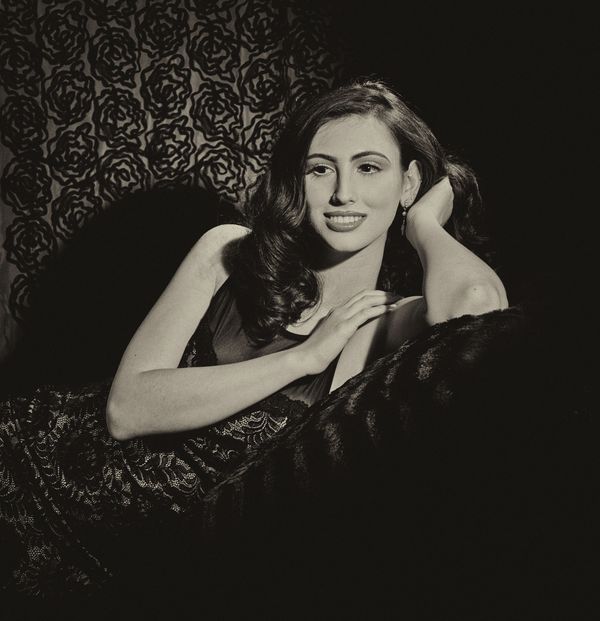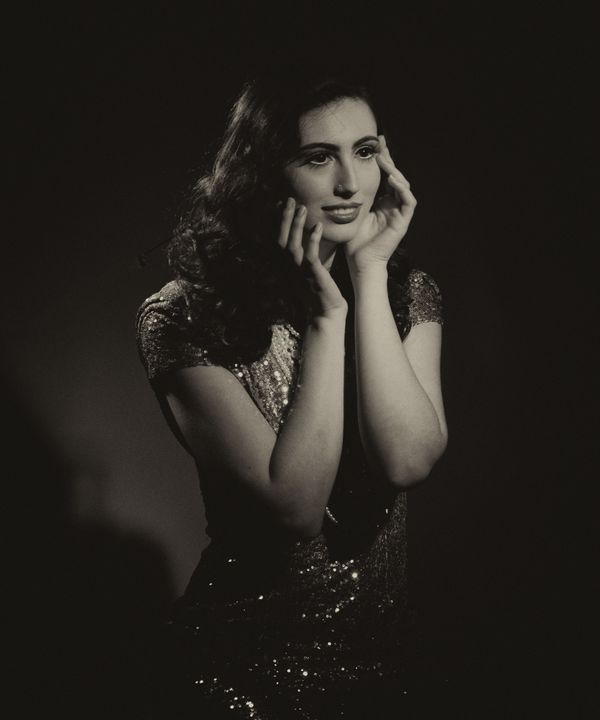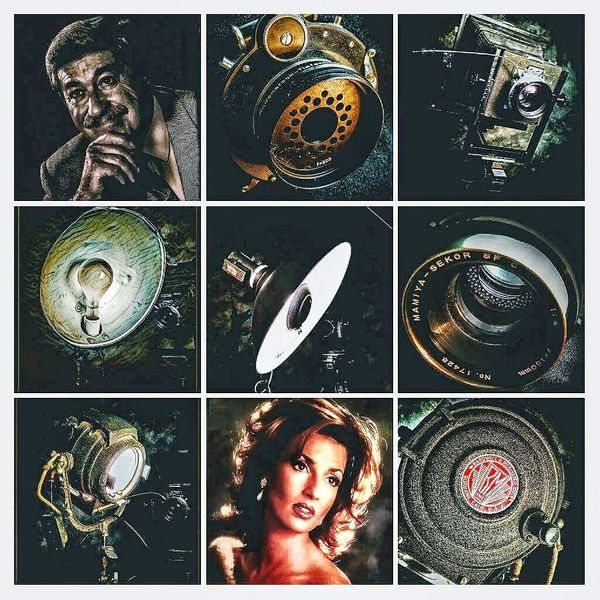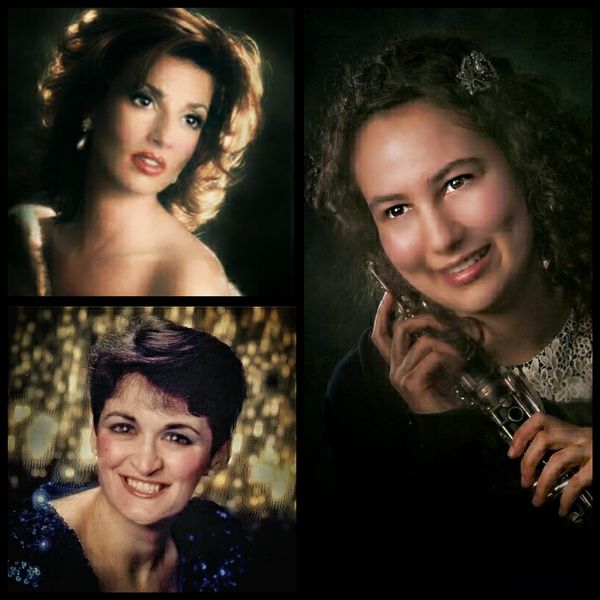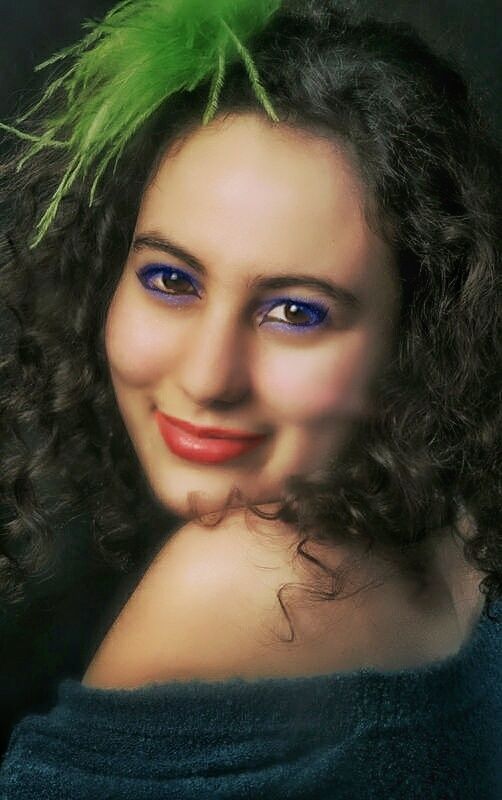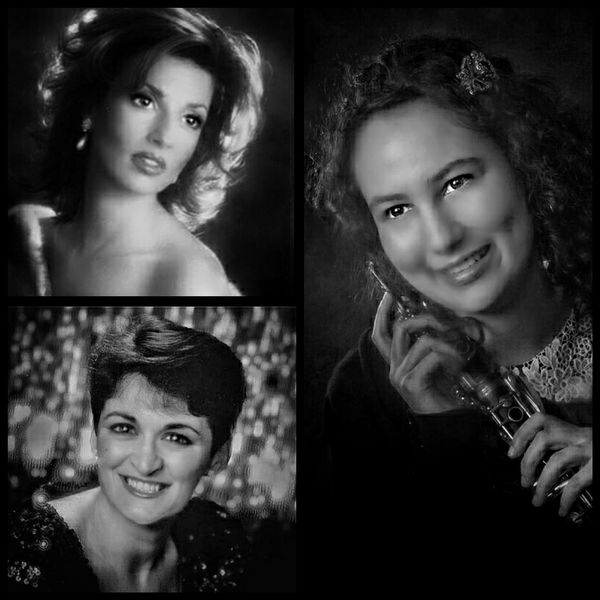Old Hollywood Glamour
Jan 27, 2018 23:03:25 #
I attended a photo shoot that recreated the Old Hollywood glamour look of the 1920's through 50's. The lighting was from three Arri 650W fresnel lamps with barn doors. There were four of us who set up the lighting in different ways. I did the black & white conversion in Nik Silver Efex Pro 2. Comments are welcome.
Jan 28, 2018 01:46:22 #
Jan 28, 2018 06:22:04 #
Jan 28, 2018 09:39:38 #
The second image is a very nice image.
The first image not so much.
Here are some comments on both images.
1) In the first image the subject is engaged with the camera with the face but not engaged with the eyes. This can often show more white of the eyes which can be problematic. Typically images are better when the eyes follow the nose.
2) The first image is a bit flat and muted for the fresnel lighting.
3) Image 1 has good hand placement. and a general relaxed pose. The expression of a slight smile is ok. I would like to have seen a different expression.
4) The hands placement in image two is ok. I am typically not a fan of hands on the face. To do hands in half body shots are difficult. They are technically correct. aka on edge..I just get the feeling when two hands are on the face that they are crawling up the face. One hand on the face is almost always better. It looks more natural and less posed.
A subjects expression in a photo can make or break a photo. Actors in most cases photograph easier than models that are not professional and better than some professional ones. Great photography is not just about light. It involves having light, subject expression and processing match to form mood. Subject expression when done with a head shot is simply facial expression. As you move to half body shots and full body shots Subject expression is as much about gesture as facial expression. The idea is thinking about what your image has to say and making those things line up with the three items i mentioned earlier. Most of the time I have those things line up but to be quite honest I never know which image i'm going to pick until I review them. I certainly don't know how the image is going to turn out until I'm done with it. sometimes thing line up and they still don't work.
What i typically do is shoot a lot of images while guiding a subject. Making sure I don;t make simple mistakes like having the plane of the nose cross the cheek.(You did well there). A professional model you can tell what expression you are looking for and they can do it. Sometimes I will photograph a subject and I will have only one expression that works. I think the difference between a really good photographer and an average one is the ability to get many expressions and then pick the correct one that has few obvious flaws.
Your post processing can help draw out the mood. Fresnel lighting is edgy because of the hard light transitions. Typically I would want to have my processing keep the white levels up because of the lighting. Image one the white level match the mood but not the lighting. Your lighting moved more to the front in image one create shallow hard light conversions....aka a somewhat flat lighting.
I wish I could describe all the things that make a good image....The bottom line is after you look at a gazillion images, you may not be able to say what makes a good image...but you will know it when you see it.
The second image is probably the best fresnel image i have seen here. Congratulations on what I consider a superb image and in the professional looking realm.
A tip for processing.
Silver effect pro is a great starting point for processing. I have personally never been able to use it alone without some curves or levels adjustments in photoshop. If your not already playing with curves and or levels in photoshop..give it a try. How you "Pull your black and whites apart: in post can make all the difference in forming mood. Silver effects just never seemed to be able to do exactly what I wanted.
Hope the commentary gives you an others something to think about.
P.S.
If you're in Colorado,Bobby Deal (a member here)has this type of lighting setup and the models too!
The first image not so much.
Here are some comments on both images.
1) In the first image the subject is engaged with the camera with the face but not engaged with the eyes. This can often show more white of the eyes which can be problematic. Typically images are better when the eyes follow the nose.
2) The first image is a bit flat and muted for the fresnel lighting.
3) Image 1 has good hand placement. and a general relaxed pose. The expression of a slight smile is ok. I would like to have seen a different expression.
4) The hands placement in image two is ok. I am typically not a fan of hands on the face. To do hands in half body shots are difficult. They are technically correct. aka on edge..I just get the feeling when two hands are on the face that they are crawling up the face. One hand on the face is almost always better. It looks more natural and less posed.
A subjects expression in a photo can make or break a photo. Actors in most cases photograph easier than models that are not professional and better than some professional ones. Great photography is not just about light. It involves having light, subject expression and processing match to form mood. Subject expression when done with a head shot is simply facial expression. As you move to half body shots and full body shots Subject expression is as much about gesture as facial expression. The idea is thinking about what your image has to say and making those things line up with the three items i mentioned earlier. Most of the time I have those things line up but to be quite honest I never know which image i'm going to pick until I review them. I certainly don't know how the image is going to turn out until I'm done with it. sometimes thing line up and they still don't work.
What i typically do is shoot a lot of images while guiding a subject. Making sure I don;t make simple mistakes like having the plane of the nose cross the cheek.(You did well there). A professional model you can tell what expression you are looking for and they can do it. Sometimes I will photograph a subject and I will have only one expression that works. I think the difference between a really good photographer and an average one is the ability to get many expressions and then pick the correct one that has few obvious flaws.
Your post processing can help draw out the mood. Fresnel lighting is edgy because of the hard light transitions. Typically I would want to have my processing keep the white levels up because of the lighting. Image one the white level match the mood but not the lighting. Your lighting moved more to the front in image one create shallow hard light conversions....aka a somewhat flat lighting.
I wish I could describe all the things that make a good image....The bottom line is after you look at a gazillion images, you may not be able to say what makes a good image...but you will know it when you see it.
The second image is probably the best fresnel image i have seen here. Congratulations on what I consider a superb image and in the professional looking realm.
A tip for processing.
Silver effect pro is a great starting point for processing. I have personally never been able to use it alone without some curves or levels adjustments in photoshop. If your not already playing with curves and or levels in photoshop..give it a try. How you "Pull your black and whites apart: in post can make all the difference in forming mood. Silver effects just never seemed to be able to do exactly what I wanted.
Hope the commentary gives you an others something to think about.
P.S.
If you're in Colorado,Bobby Deal (a member here)has this type of lighting setup and the models too!
Jan 28, 2018 11:51:44 #
Jan 28, 2018 20:25:19 #
I always enjoy learning and reading all the tips and help posted here by PalePictures. Thank you.
Jan 29, 2018 11:19:09 #
These are really so nice. I have also learned a lot from Russ! But I did enjoy seeing your first one too! I feel like the first one she is in mid conversation and paparazzi caught her lounging!
Feb 1, 2018 14:52:33 #
HOORAY FOR HOLLYWOOD! That's a great song and I have always been a big fan and kinda practitioner of the HOLLYWOOD style. I have been into classical fine portraiture for many decades and the old Hollywood style is something that I offer as one of the options at my studio. I am not trying to replicate the style in a costume sense or a sort of “old tyme” photography, but rather integrating some of the time-honored methodologies that many of the iconic theatrical photographers introduced many years ago.
The Fresnel spot: Back in the day, in some motion picture production studios, it was traditional have the movie crew vacate the set to turn it over to the stills photographer for photo calls. The photographer would oftentimes use a large format camera (8X10 was not uncommon) and have access to all the cinematographic lighting and support gear such a platforms and cranes (this made for some great camera angles). The Fresnel spot was popular in that it could be precisely controlled and aimed at actors, from a distance far enough to remain out of the camera's field and still enabled maximum control over lighting patterns and styles. Some photographers brought smaller versions of theses spotlight into their studios as well. The lighting quality is considerably harsher that any kind of flood, parabolic or diffused light source and oftentimes I find the results not sufficiently modulated. I subscribe to a time-honored usage of my Fresnel spots in that I FEATHER the lights that is, using the edge of the beam rather that the central “hot spot”. I will aim the light, establish the pattern I am after and then gently rotate the lights toward the camera position, closely observing their effect on the subjects face. At one point the transition from highlight to shadow will become smoother and the specular highlights will pop! The same technique also applies to parabolic reflector equipped flood lights, umbrella and soft-box systems.
I love photographing the ladies but y'all Hollywood fans shouldd get into some photographing some guys as well- remember the iconic photos of leading actors. Back in the day, many of the male actors and character actors and even some of the more ultra-dramatic portraits of the ladies were made on ORTHOCHROMATIC film. This film, being somewhat “red-blind”, delivered very robust skin tones. To my knowledge, that film is no longer in manufacture anywhere and of course, most of us are into digital photography. To simulate that “look” you can shoot in monochrome and use a GREEN filter on your lens. Inversely, for a more “porcelain” kind skin tone, some theatrical photographers used a film called RS Pan- that stuff was super red sensitive and helped to obscure any kind of ruddy or blemished complexion. Technica Pan had that kinda look too, but it too is gone. To simulate that look, try a yellow or orange filter on the lens and shoot in monochrome.
Some of theses technique will save excessive processing and retouching. Remember, many of those iconic old timers shot on 8X10 film and plates. If you look closely at some of the classic theatrical photos, published in books, you will not notice as much grain but you may detect that the images are nearly totally comprised of of tiny “figure-eights” or similar strokes- many of the negatives were completely retouched almost edge to edge- there is more lead pencil that film stricture! Also, highlights were enhanced and shadows were semi-opaqued with a red due called Cosine(Sp?) to hold back the shadows. Noways we need to retain shadow detail with sufficient exposure in that end of the scale and bring the highlight up in lighting.
Another Hollywood tradition, also somewhat derived from old cinematography is SOFT FOCUS. I use a number of prime soft focus lenses or a high quality diffusion filters. Good soft focus imagery is not UN-focused or degraded sharpness. It can be based on a secondary soft image superimposed over a sharp base image or a concept where the highlights are gently blended into the shadows. The Rodenstock Imagon lenses and the Sekor SF-150mm for my RZ camera are my favorite primes for this application. The Zeiss SOFTAR and the Harrison & Harrison Diffusion filters are what I recommend as the go-to filters for this style. The latter are the choice of many cinematographers. Canon made a 135mm soft focus lens for their DSLRs- I am trying to track one down.
At my studio, the majority of my clients are not actors or models- we get a few from time to time but most are regular folks who may like a bit of glam in their portraits. Of they like the style, I get out my trusty Bardwell and McAlister Fresnel spots and have a go at it- I like my old hot light, floods and giant beauty light (Circa 1959) too.
Presently, my office is being renovated (whata mess) and all my computers are in for re-fits and replacement. The operating systems are long gone and some of the hard drives have had it. So for a few weeks I am on my i-phone so please excuse any dreadful typos and lousy picture reproduction. I will post a few image in the next reply box- have a look. The are presently stored in my PHONE!
I hope y'all find this somewhat useful and may want to integrate some of it into your work. If anyone has a question or comment- please do not hesitate to post it. Thanks for posting in this section.
The Fresnel spot: Back in the day, in some motion picture production studios, it was traditional have the movie crew vacate the set to turn it over to the stills photographer for photo calls. The photographer would oftentimes use a large format camera (8X10 was not uncommon) and have access to all the cinematographic lighting and support gear such a platforms and cranes (this made for some great camera angles). The Fresnel spot was popular in that it could be precisely controlled and aimed at actors, from a distance far enough to remain out of the camera's field and still enabled maximum control over lighting patterns and styles. Some photographers brought smaller versions of theses spotlight into their studios as well. The lighting quality is considerably harsher that any kind of flood, parabolic or diffused light source and oftentimes I find the results not sufficiently modulated. I subscribe to a time-honored usage of my Fresnel spots in that I FEATHER the lights that is, using the edge of the beam rather that the central “hot spot”. I will aim the light, establish the pattern I am after and then gently rotate the lights toward the camera position, closely observing their effect on the subjects face. At one point the transition from highlight to shadow will become smoother and the specular highlights will pop! The same technique also applies to parabolic reflector equipped flood lights, umbrella and soft-box systems.
I love photographing the ladies but y'all Hollywood fans shouldd get into some photographing some guys as well- remember the iconic photos of leading actors. Back in the day, many of the male actors and character actors and even some of the more ultra-dramatic portraits of the ladies were made on ORTHOCHROMATIC film. This film, being somewhat “red-blind”, delivered very robust skin tones. To my knowledge, that film is no longer in manufacture anywhere and of course, most of us are into digital photography. To simulate that “look” you can shoot in monochrome and use a GREEN filter on your lens. Inversely, for a more “porcelain” kind skin tone, some theatrical photographers used a film called RS Pan- that stuff was super red sensitive and helped to obscure any kind of ruddy or blemished complexion. Technica Pan had that kinda look too, but it too is gone. To simulate that look, try a yellow or orange filter on the lens and shoot in monochrome.
Some of theses technique will save excessive processing and retouching. Remember, many of those iconic old timers shot on 8X10 film and plates. If you look closely at some of the classic theatrical photos, published in books, you will not notice as much grain but you may detect that the images are nearly totally comprised of of tiny “figure-eights” or similar strokes- many of the negatives were completely retouched almost edge to edge- there is more lead pencil that film stricture! Also, highlights were enhanced and shadows were semi-opaqued with a red due called Cosine(Sp?) to hold back the shadows. Noways we need to retain shadow detail with sufficient exposure in that end of the scale and bring the highlight up in lighting.
Another Hollywood tradition, also somewhat derived from old cinematography is SOFT FOCUS. I use a number of prime soft focus lenses or a high quality diffusion filters. Good soft focus imagery is not UN-focused or degraded sharpness. It can be based on a secondary soft image superimposed over a sharp base image or a concept where the highlights are gently blended into the shadows. The Rodenstock Imagon lenses and the Sekor SF-150mm for my RZ camera are my favorite primes for this application. The Zeiss SOFTAR and the Harrison & Harrison Diffusion filters are what I recommend as the go-to filters for this style. The latter are the choice of many cinematographers. Canon made a 135mm soft focus lens for their DSLRs- I am trying to track one down.
At my studio, the majority of my clients are not actors or models- we get a few from time to time but most are regular folks who may like a bit of glam in their portraits. Of they like the style, I get out my trusty Bardwell and McAlister Fresnel spots and have a go at it- I like my old hot light, floods and giant beauty light (Circa 1959) too.
Presently, my office is being renovated (whata mess) and all my computers are in for re-fits and replacement. The operating systems are long gone and some of the hard drives have had it. So for a few weeks I am on my i-phone so please excuse any dreadful typos and lousy picture reproduction. I will post a few image in the next reply box- have a look. The are presently stored in my PHONE!
I hope y'all find this somewhat useful and may want to integrate some of it into your work. If anyone has a question or comment- please do not hesitate to post it. Thanks for posting in this section.
Feb 1, 2018 14:59:42 #
Feb 1, 2018 17:25:47 #
Thanks to everyone for the great advice and insight into how images were made in the good ole' Hollywood glamour days.
If you want to reply, then register here. Registration is free and your account is created instantly, so you can post right away.

